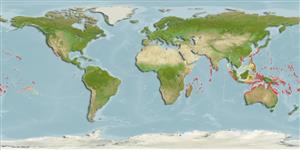Common names from other countries
Environment: milieu / climate zone / depth range / distribution range
Ecología
marino; salobre asociado a arrecife; rango de profundidad 0 - 6 m (Ref. 86942). Tropical; 32°N - 24°S
Indo-Pacific: East Africa to the Hawaiian, Marquesan and Tuamoto islands, north to southern Japan.
Tamaño / Peso / Age
Maturity: Lm ? range ? - ? cm
Max length : 11.0 cm TL macho / no sexado; (Ref. 2798)
Espinas dorsales (total): 7; Radios blandos dorsales (total): 9; Espinas anales 1; Radios blandos anales: 8. Characterized by mottled brown overall color; presence of broad dark grey bar below each dorsal fin; basal part of dorsal and caudal fins with dark spots forming bands; upper 5-7 pectoral rays partly free of membrane, uppermost with 5-7 branches; rounded caudal fin; longitudinal scale series 35-39; predorsal scales 21-23, extending to interorbital space; presence of scales on cheek and opercle; ctenoid body scales, becoming smaller and cycloid on head and anterior body; depressed head, width greater than depth; depth of body 4.2-5.0 in SL (Ref. 90102).
Benthic in rocks and coral of shallow waters (Ref. 58302). Also occurs in rocky pools of intertidal reef flats and exposed rocky shores in 0-2 m (Ref. 90102).
Life cycle and mating behavior
Madurez | Reproducción | Puesta | Huevos | Fecundidad | Larva
Myers, R.F., 1991. Micronesian reef fishes. Second Ed. Coral Graphics, Barrigada, Guam. 298 p. (Ref. 1602)
IUCN Red List Status (Ref. 130435)
CITES (Ref. 128078)
Not Evaluated
Threat to humans
Harmless
Human uses
Más información
ReferenciasAcuiculturaPerfil de acuiculturaRazasGenéticaElectrophoresesheritabilidadEnfermedadesProcesamientoMass conversion
Herramientas
Special reports
Download XML
Fuentes de Internet
Estimates based on models
Preferred temperature (Ref.
115969): 24.9 - 29.3, mean 28.2 (based on 2181 cells).
Phylogenetic diversity index (Ref.
82804): PD
50 = 0.5000 [Uniqueness, from 0.5 = low to 2.0 = high].
Bayesian length-weight: a=0.01023 (0.00477 - 0.02194), b=3.02 (2.84 - 3.20), in cm Total Length, based on LWR estimates for this (Sub)family-body shape (Ref.
93245).
Nivel trófico (Ref.
69278): 3.5 ±0.5 se; based on size and trophs of closest relatives
Resiliencia (Ref.
120179): Alto, población duplicada en un tiempo mínimo inferior a 15 meses (Preliminary K or Fecundity.).
Fishing Vulnerability (Ref.
59153): Low vulnerability (10 of 100).
